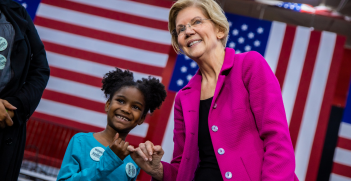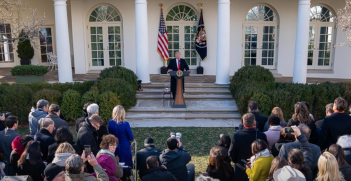The Democratic Divide in the US House of Representatives

Democratic voters have rejected progressive representation in the executive branch once again. The ideological polarisation within the Democratic Party has multiple implications for the future of the progressive wing in the House of Representatives.
The 116th US Congress has featured a turbulent and conflictive House of Representatives characterised by a stark internal divide within the Democratic majority. This has been partially advanced by the surge of a progressive wing in the House that seeks to shift the power dynamics in Congress. While impactful, the US has still chosen to dismiss democratic-socialism in the form of presidential representation by again rejecting the front man of the far-left, Bernie Sanders. This development imposes many implications for the reformist movement in the House.
In the 2018 midterm election, the Democrats flipped 41 seats to gain a 36-seat advantage in the House. The 2018 “blue wave” was reinforced by the election of a young, progressive core of reformist Democrats. This movement was led by “The Squad,” made up of young, liberal congresswomen Alexandria Ocasio-Cortez, Rashida Tlaib, Ilhan Omar, and Ayanna Pressley. This group, which was sponsored by Justice Democrats, a progressive political action committee, looked to attack establishment politics through the promotion of radical legislation and proposals, which have been pivotal in unsettling the Democratic Party itself.
Nevertheless, a strong South Carolina turnout for former Vice President Joe Biden in the 2020 Democratic primary proved that once again, the blue base would revert to the electable middle-ground in hope of fighting fire with moderation come November. After losing ten of the 14 states on Super Tuesday, resulting in an 84-delegate deficit, the dismissal of Bernie was clear and the path to his early-April campaign suspension became inevitable.
With the Democrats choosing to not turn out for Bernie, delivering him progressively poorer performances in every Democratic primary, the support for progressive representation in Congress comes into question. However, securing the presidential nominee is only one of many battles that Democrats will be forced to engage with this year. The choice to continue the progressive transformation of the House is not only key in battleground states. It is also equally significant in the battle for solidifying a Democratic identity in strong blue states such as Illinois and Minnesota. The internal ideological rift between the growing progressive Democrat wing and the moderate base, headed by Speaker of the House Nancy Pelosi, is not one that Democrats can afford to fight for in the background whilst contending for the presidency and for increased control in the Republican-held senate.
This internal party exchange was displayed in a rare 2020 highlight for progressive Democrats. In the Democratic primary bid for Illinois’ third congressional district, Progressive entrepreneur Marie Newman overcame 15-year incumbent Dan Lipinski. Newman, who was backed by Justice Democrats, ran on the back of a healthcare-for-all campaign to garner a youthful base of progressive supporters that saw her overtake a centrist Democratic congressman in the same fashion as Ocasio-Cortez and Pressley in 2018.
Republicans underwent a similar internal confrontation during the 2016 presidential election. The initial conservative denunciation of then-nominee, Donald Trump, by “purple states” and the conservative media was equally apparent during the entirety of the campaign. However, this was not so much an ideological opposition as it was a character and legitimacy debate. The result was the gradual transition to a larger legion of support with each incremental victory that Trump brought the GOP in the 2016 general election. This was extended to the Republican retention of both the House and the Senate in the 115th Congress.
A key difference with the current Democratic dilemma, is that the forceful and influential ideology of the new progressive wing is inherently incompatible with traditional Democratic Party politics. The proposition of radical reformation from new progressives damages the consensus-orientated approach of left-wing populism valued by the traditional Democratic Party. As a result, the party suffers by splitting allegiance between centrist appeal and ideological evolution. Even with Bernie’s ultimate endorsement of Biden, the Democrats have not yet proven that they will be able to find an identity that appeals to critical battleground states. It is important to note that however damaging this House battle is for the Democrats, it is an inevitable one. The safe centre-left control in states such as Virginia and North Carolina will not be enough to combat the growth in increasingly progressive Democratic House representatives in power-blocs such as Pennsylvania and Oregon, both of which have more than half of their House representatives in the Congressional Progressive Caucus.
This internal battle for identity within the Democratic Party is unmistakably reinforced by a generational divide in the Democratic base. Older Democratic voters are typically more resistant to systematic restructuring, whereas younger Democrats are more in favour of reformation. Of course, it is to be expected that the party that champions reformation would experience clearer age-related clashes, but this should not result in a mediocre compromise.
In the election of Joe Biden as presidential nominee, exit poll data underlines a positive future for progressive Democrats, as well as a clear generational divide within the party. In Michigan, potentially the most important battleground state, Biden confidently won the Democratic primary with 52.9 percent against Bernie’s 34.6 percent. However, Bernie swept in the 18-24, 25-29, and 30-39 age groups, claiming 76 percent, 72 percent and 53 percent of votes, respectively. Furthermore, Bernie confidently claimed the lowest age bracket vote with 70 percent in Missouri and 55 percent in Virginia – two states that were amongst Bernie’s worst overall performances, with 34.6 percent and 23.1 percent of votes, respectively.
Whether this indicates that the progressive House movement will also continue to claim the youth vote but fail to drive a high enough voter turnout will be revealed in the November election. With Elizabeth Warren appearing as the precarious front-runner for Biden’s vice-presidential choice, the implications of this become even more uncertain. Offering progressive representation in the executive branch could motivate young progressives to also support House candidates with similar outlooks. But, this choice could also discourage this same key demographic from getting involved in the House elections, as many view Warren’s refusal to drop out of the primaries and endorse Bernie after Super Tuesday as a key determining factor in his failure.
Ultimately, it is important to not overlook the fact that ahead of the November general election, the Democratic National Convention’s only House priority is to retain and increase its majority. The small, yet loud, progressive wing of House Democrats does not directly benefit the Democratic Party’s goal for congressional control. The Democratic Congressional Campaign Committee (DCCC) has targeted 47 open or Republican-held seats that have been filled with progressive and traditional Democratic candidates alike. The races that will be particularly telling for progressive Democrats will transpire in the various DCCC-targeted seats in Texas that have shown electoral vulnerability, as well as seats in regions with fluctuating allegiances, such as central Florida.
Despite inconsistent support since the 2018 “blue wave,” the progressive wing maintains a portion of the House of Representatives that has unapologetically attacked the identity of the Democratic Party. Expect the 117th Congress to entail an elevated version of this same Democratic divide, and inversely for the Republicans, to further solidify their smaller yet more unified grouping in the House. The November election will feature an internal battle within a cross-party battle, and the prelude is well underway.
Henry Heritage is a graduate policy officer in the Queensland government. Henry earned a Bachelor of International Studies majoring in International Relations from the University of Wollongong and will be starting a Graduate Certificate in International Relations at Deakin University. Last year, Henry completed a congressional internship in Washington, D.C.
This article is published under a Creative Commons Licence and may be republished with attribution.





